AWM137 2/1 - Historical information and general development of the RAAF Nursing Service - Notes of History of the RAAF Nursing Service 1940-1944 - Part 4
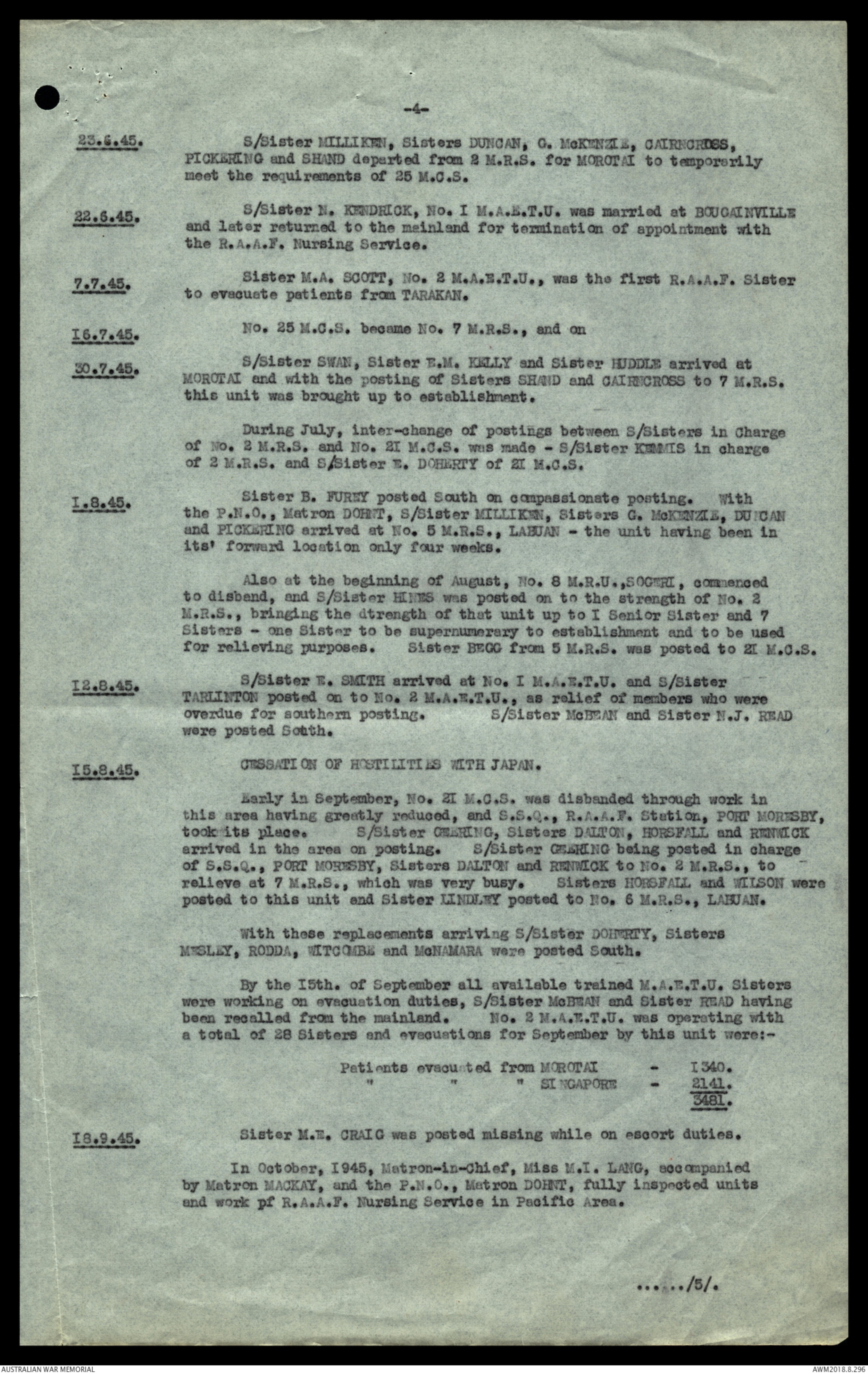
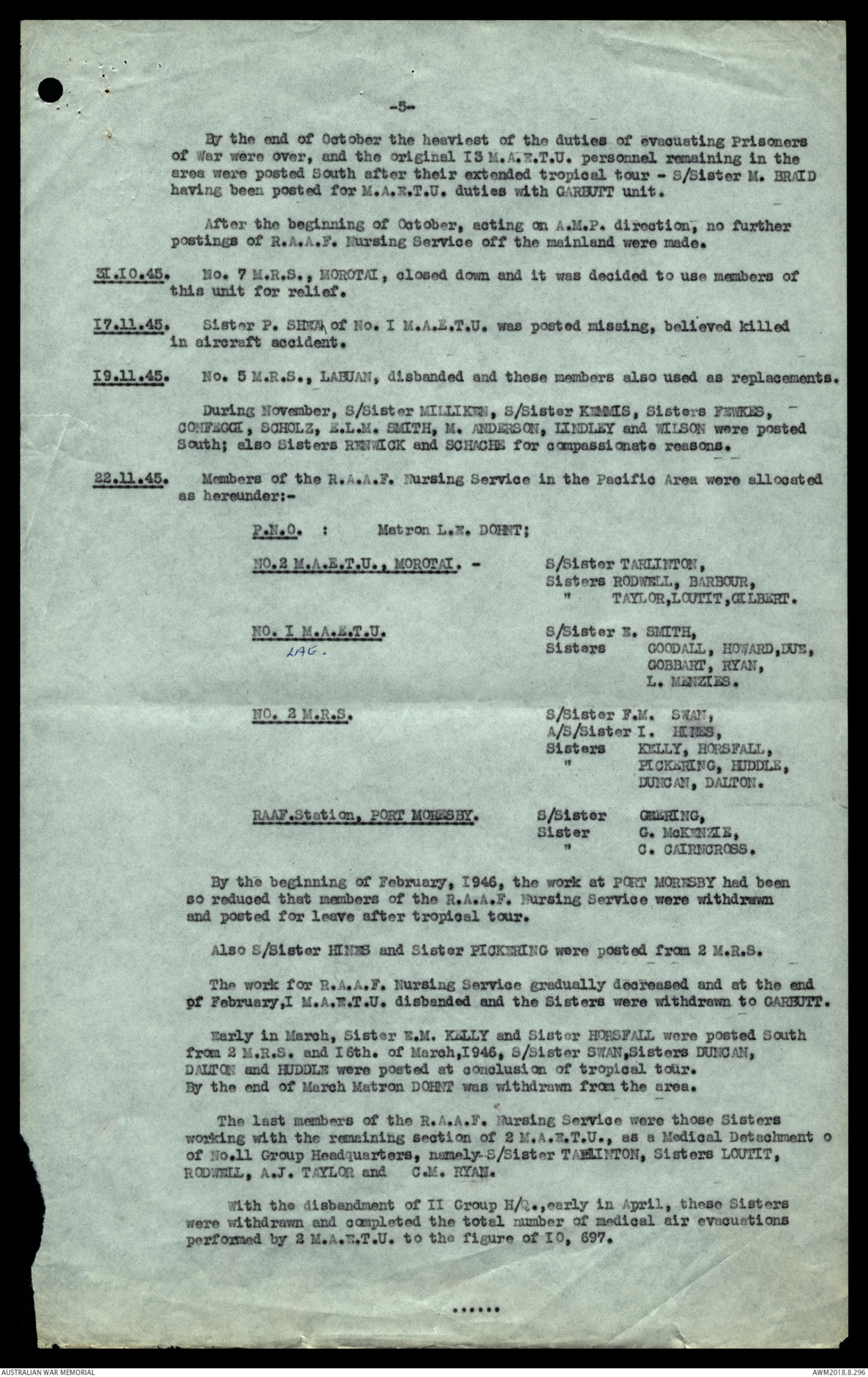
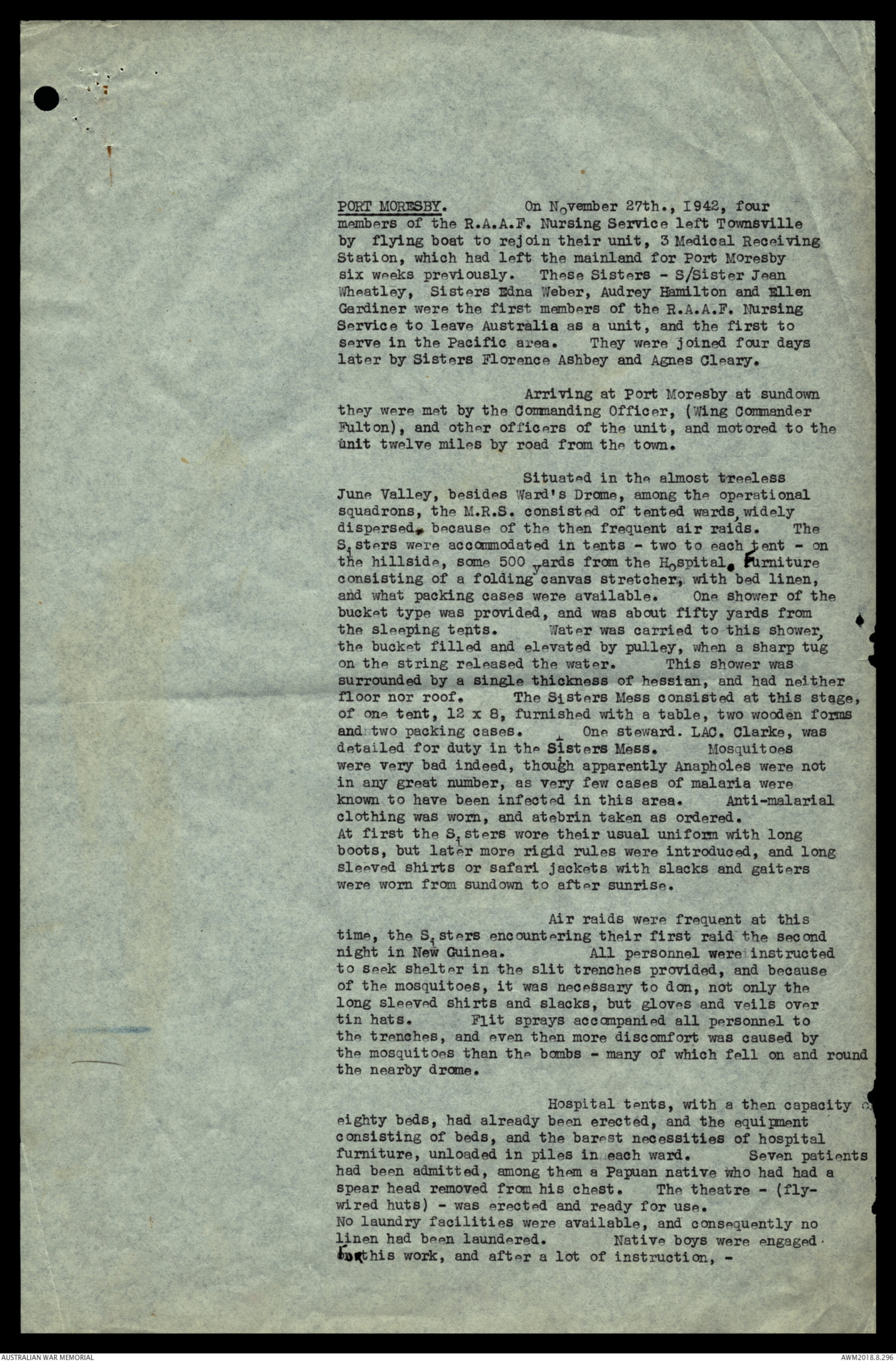
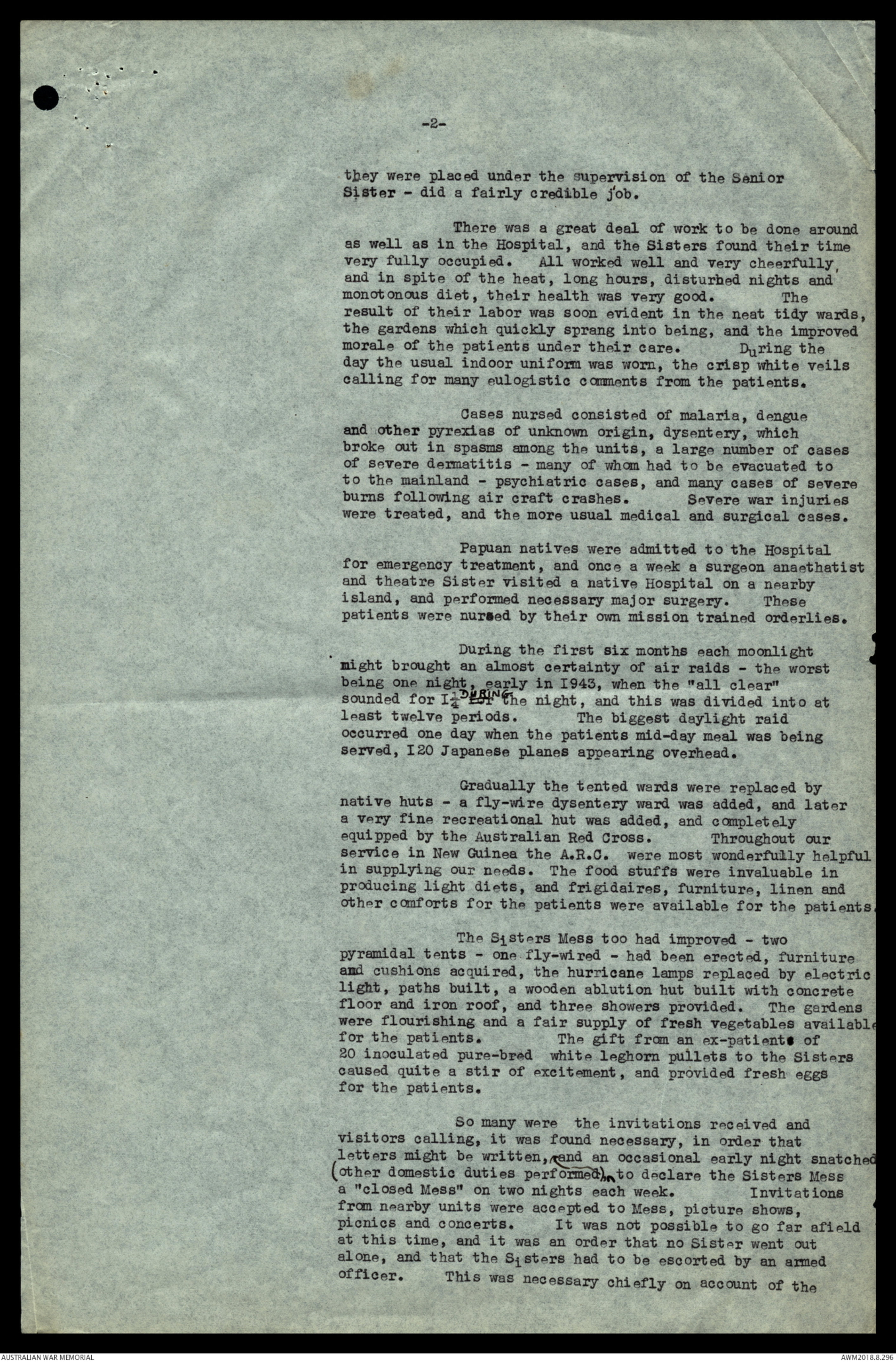



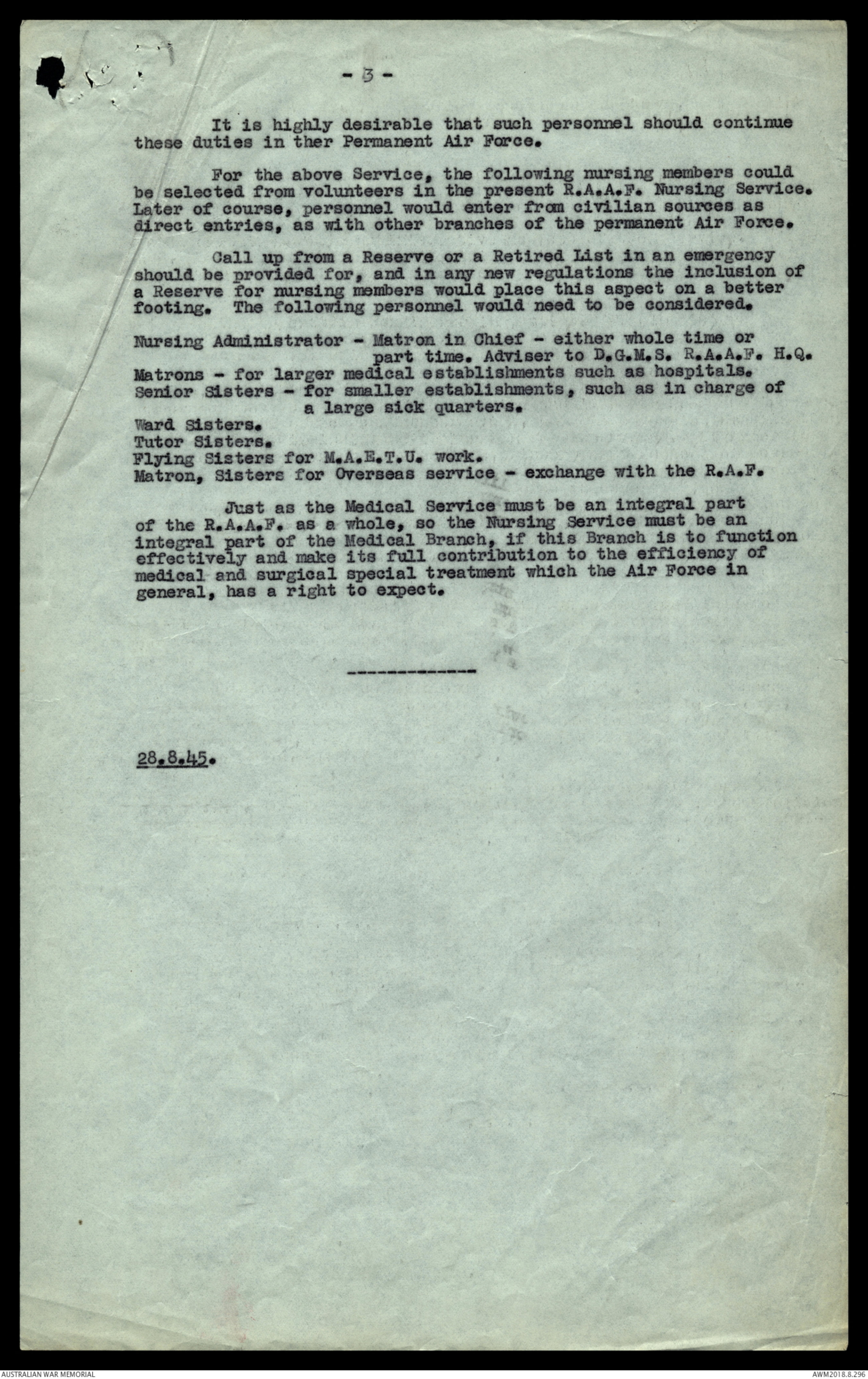
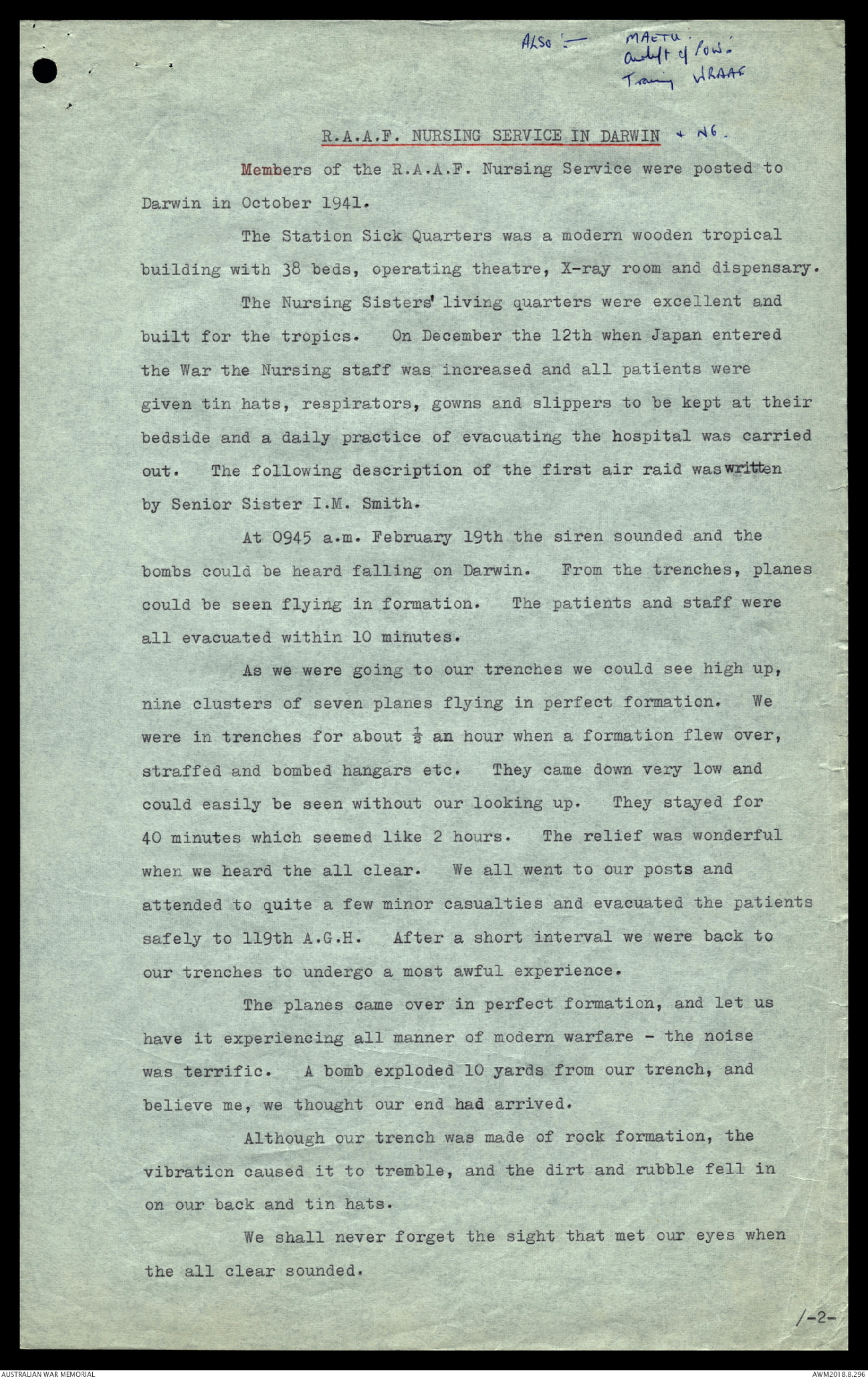
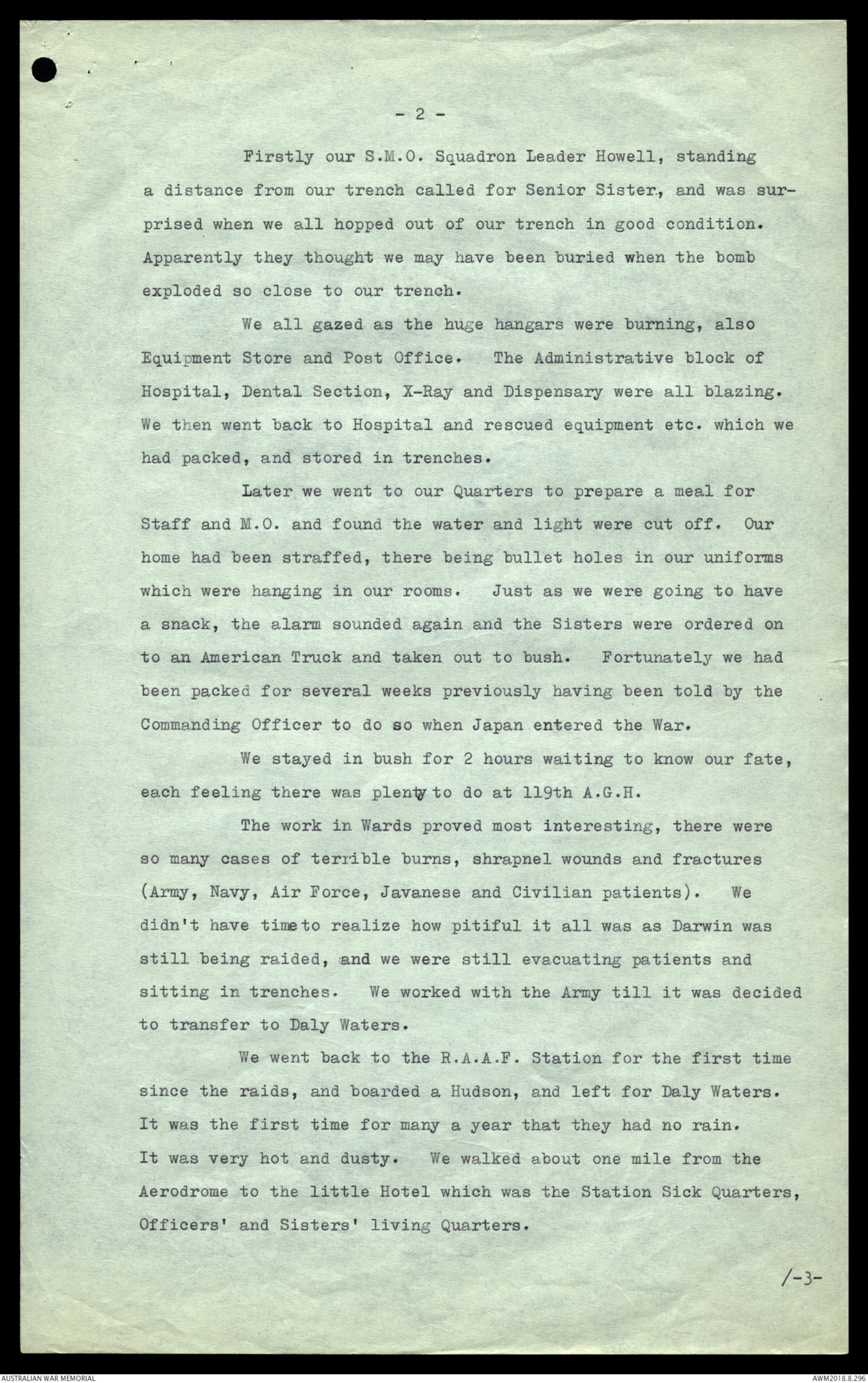
-4-
23.6.45. S/Sister MILLIKEN, Sisters DUNCAN, G. McKENZIE, CAIRNCROSS,
PICKERING and SHAND departed from 2 M.R.S. for MOROTAI to temporarily
meet the requirements of 25 M.C.S.
22.6.45. S/Sister N. KENDRICK, No. 1 M.A.E.T.U. was married at BOUGAINVILLE
and later returned to the mainland for termination of appointment with
the R.A.A.F. Nursing Service.
7.7.45. Sister M.A. SCOTT, No. 2 M.A.E.T.U., was the first R.A.A.F. Sister
to evacuate patients from TARAKAN.
16.7.45. No. 25 M.C.S. became No. 7 M.R.S., and on
30.7.45. S/Sister SWAN, Sister E.M. KELLY and Sister HUDDLE arrived at
MOROTAI and with the posting of Sisters SHAND and CAIRNCROSS to 7 M.R.S.
this unit was brought up to establishment.
During July, inter-change of postings between S/Sisters in Charge
of No. 2 M.R.S. and No. 21 M.C.S. was made - S/Sister KEMMIS in charge
of 2 M.R.S. and S/Sister E. DOHERTY of 21 M.C.S.
1.8.45. Sister B. FUREY posted South on compassionate posting. With
the P.N.O., Matron DOHNT, S/Sister MILLIKEN, Sisters G. McKENZIE, DUNCAN
and PICKERING arrived at No. 5 M.R.S., LABUAN - the unit having been in
its' forward location only four weeks.
Also at the beginning of August, No. 8 M.R.U.,SOGERI, commenced
to disband, and S/Sister HINES was posted on to the strength of No. 2
M.R.S., bringing the dtrength of that unit up to 1 Senior Sister and 7
Sisters - one Sister to be supernumerary to establishment and to be used
for relieving purposes. Sister BEGG from 5 M.R.S. was posted to 21 M.C.S.
12.8.45. S/Sister E. SMITH arrived at No. 1 M.A.E.T.U. and S/Sister
TARLINTON posted on to No. 2 M.A.E.T.U., as relief of members who were
overdue for southern posting. S/Sister McBEAN and Sister N.J. READ
were posted South.
15.8.45. CESSATION OF HOSTILITIES WITH JAPAN.
Early in September, No. 21 M.C.S. was disbanded through work in
this area having greatly reduced, and S.S.Q., R.A.A.F. Station, PORT MORESBY,
took its place. S/Sister GEERING Sisters DALTON, HORSFALL and RENWICK
arrived in the area on posting. S/Sister GEERING being posted in charge
of S.S.Q., PORT MORESBY, Sisters DALTON and RENWICK to No. 2 M.R.S., to
relieve at 7 M.R.S., which was very busy. Sisters HORSFALL and WILSON were
posted to this unit and Sister LINDLEY posted to No. 6 M.R.S., LABUAN.
With these replacements arriving S/Sister DOHERTY, Sisters
MESLEY, RODDA, WITCOMBE and McNAMARA were posted South.
By the I5th. of September all available trained M.A.E.T.U. Sisters
were working on evacuation duties, S/Sister McBEAN and Sister READ having
been recalled from the mainland. No. 2 M.A.E.T.U. was operating with
a total of 28 Sisters and evacuations for September by this unit were:-
Patients evacuated from MOROTAI - 1340.
" " " SINGAPORE - 2141.
3481.
18.9.45. Sister M.E. CRAIG was posted missing while on escort duties.
In October, 1945, Matron-in-Chief, Miss M.I. LANG, accompanied
by Matron MACKAY, and the P.N.O., Matron DOHNT, fully inspected units
and work pf R.A.A.F. Nursing Service in Pacific Area.
..../5/.
-5-
By the and of October the heaviest of the duties of evacuating Prisoners
of War were over, and the original 13 M.A.E.T.U. personnel remaining in the
area were posted South after their extended tropical tour -S/Sister M. BRAID
having been posted for M.A.E.T.U. duties with GARBUTT unit.
After the beginning of October, acting on A.M.P. direction, no further
postings of R.A.A.F. Nursing Service off the mainland were made.
31.10.45. No. 7 M.R.S., MOROTAI, closed down and it was decided to use members of
this unit for relief.
17.11.45. Sister P. SHEA of No. 1 M.A.E.T.U. was posted missing, believed killed
in aircraft accident.
19.11.45. No. 5 M.R.S., LABUAN, disbanded and these members also used as replacements.
During November, S/Sister MILLIKEN, S/Sister KEMMIS, Sisters FEWKES,
CONFEGGI, SCHOLZ, E.L.M. SMITH, M. ANDERSON, LINDLEY and WILSON were posted
South; also Sisters RENWICK and SCHACHE for compassionate reasons.
22.11.45. Members of the R.A.A.F. Nursing Service in the Pacific Area were allocated
as hereunder:-
P.N.O. : Matron L.E. DOHNT:
No.2.M.A.E.T.U., MOROTAI. - S/Sister TARLINTON
Sisters RODWELL, BARBOUR
" TAYLOR, LOUTIT, GILBERT.
NO. 1 M.A.E.T.U. S/Sister E.SMITH
LAE Sisters GOODALL, HOWARD, DUE,
GOBBART, RYAN,
L. MENZIES.
NO. 2 M.R.S. S/Sister F.M. SWAN,
A/S/Sister I. HINES,
Sisters KELLY, HORSFALL,
" PICKERING, HUDDLE,
" DUNCAN, DALTON.
R.A.A.F.Station, PORT MORESBY. S/Sister GEERING,
Sister G. McKENZIE,
" C. CAIRNCROSS.
By the beginning of February, 1946, the work at PORT MORESBY had been
so reduced that members of the R.A.A.F. Nursing Service were withdrawn
and posted for leave after tropical tour.
Also S/Sister HINES and Sister PICKERING were posted from 2 M.R.S.
The work for R.A.A.F. Nursing Service gradually decreased and at the end
of February,I M.A.E.T.U. disbanded and the Sisters were withdrawn to GARBUTT.
Early in March, Sister E.M. KELLY and Sister HORSFALL were posted South
from 2 M.R.S. and 16th. of March,1946, S/Sister SWAN,Sisters DUNCAN,
DALTON and HUDDLE were posted at conclusion of tropical tour.
By the end of March Matron DOHNT was withdrawn from the area.
The last members of the R.A.A.F. Nursing Service were those Sisters
working with the remaining section of 2 M.A.E.T.U., as a Medical Detachment o
of No.11 Group Headquarters, namely-S/Sister TARLINTON, Sisters LOUTIT,
RODWELL, A.J. TAYLOT and C.M. RYAN.
With the disbandment of 11 Group H/Q.,early in April, these Sisters
were withdrawn and completed the total number of medical air evacuations
performed by 2 M.A.E.T.U. to the figure of 10, 697.
PORT MORESBY. On November 27th., I942, four
members of the R.A.A.F. Nursing Service left Townsville
by flying boat to rejoin their unit, 3 Medical Receiving
Station, which had left the mainland for Port Moresby
six weeks previously. These Sisters - S/Sister Jean
Wheatley, Sisters Edna Weber, Audrey Hamilton and Ellen
Gardiner were the first members of the R.A.A.F. Nursing
Service to leave Australia as a unit, and the first to
serve in the Pacific area. They were joined four days
later by Sisters Florence Ashbey and Agnes Cleary.
Arriving at Port Moresby at sundown
they were met by the Commanding Officer, (Wing Commander
Fulton), and other officers of the unit, and motored to the
unit twelve miles by road from the town.
Situated in the almost treeless
June Valley, besides Ward's Drome, among the operational
squadrons, the M.R.S. consisted of tented wards, widely
dispersed, because of the then frequent air raids. The
Sisters were accommodated in tents - two to each tent - on
the hillside, some 500 yards from the Hospital. Furniture
consisting of a folding canvas stretcher, with bed linen,
and what packing cases were available. One shower of the
bucket type was provided, and was about fifty yards from
the sleeping tents. Water was carried to this shower,
the bucket filled and elevated by pulley, when a sharp tug
on the string released the water. This shower was
surrounded by a single thickness of hessian, and had neither
floor nor roof. The Sisters Mess consisted at this stage,
of one tent, 12 x 8, furnished with a table, two wooden forms
and two packing cases. One steward. LAC. Clarke, was
detailed for duty in the Sisters Mess. Mosquitoes
were very bad indeed, though apparently Anapholes were not
in any great number, as very few cases of malaria were
known to have been infected in this area. Anti-malarial
clothing was worn, and atebrin taken as ordered.
At first the Sisters wore their usual uniform with long
boots, but later more rigid rules were introduced, and long
sleeved shirts or safari jackets with slacks and gaiters
were worn from sundown to after sunrise.
Air raids were frequent at this
time, the Sisters encountering their first raid the second
night in New Guinea. All personnel were instructed
to seek shelter in the slit trenches provided, and because
of the mosquitoes, it was necessary to don, not only the
long sleeved shirts and slacks, but gloves and veils over
tin hats. Flit sprays accompanied all personnel to
the trenches, and even then more discomfort was caused by
the mosquitoes than the bombs - many of which fell on and round
the nearby drome.
Hospital tents, with a then capacity
eighty beds, had already been erected, and the equipment
consisting of beds, and the barest necessities of hospital
furniture, unloaded in piles in each ward. Seven patients
had been admitted, among them a Papuan native who had had a
spear head removed from his chest. The theatre - (fly-
wired huts) - was erected and ready for use.
No laundry facilities were available, and consequently no
linen had been laundered. Native boys were engaged
for this work, and after a lot of instruction, -
-2-
they were placed under the supervision of the Senior
Sister - did a fairly credible job.
There was a great deal of work to be done around
as well as in the Hospital, and the Sisters found their time
very fully occupied. All worked well and very cheerfully,
and in spite of the heat, long hours, disturbed nights and
monotonous diet, their health was very good. The
result of their labor was soon evident in the neat tidy wards,
the gardens which quickly sprang into being, and the improved
morale of the patients under their care. During the
day the usual indoor uniform was worn, the crisp white veils
calling for many eulogistic comments from the patients.
Cases nursed consisted of malaria, dengue
and other pyrexias of unknown origin, dysentery, which
broke out in spasms among the units, a large number of cases
of severe dermatitis - many of whom had to be evacuated to
to the mainland - psychiatric cases, and many cases of severe
burns following air craft crashes. Severe war injuries
were treated, and the more usual medical and surgical cases.
Papuan natives were admitted to the Hospital
for emergency treatment, and once a week a surgeon anaethatist
and theatre Sister visited a native Hospital on a nearby
island, and performed necessary major surgery. These
patients were nursed by their own mission trained orderlies.
During the first six months each moonlight
night brought an almost certainty of air raids - the worst
being one night, early in 1943, when the "all clear"
sounded for 1 1/4 for DURING the night, and this was divided into at
least twelve periods. The biggest daylight raid
occurred one day when the patients mid-day meal was being
served, 120 Japanese planes appearing overhead.
Gradually the tented wards were replaced by
native huts - a fly-wire dysentery ward was added, and later
a very fine recreational hut was added, and completely
equipped by the Australian Red Cross. Throughout our
service in New Guinea the A.R.C. were most wonderfully helpful
in supplying our needs. The food stuffs were invaluable in
producing light diets, and frigidaires, furniture, linen and
other comforts for the patients were available for the patients.
The Sisters Mess too had improved - two
pyramidal tents - one fly-wired - had been erected, furniture
and cushions acquired, the hurricane lamps replaced by electric
light, paths built, a wooden ablution hut built with concrete
floor and iron roof, and three showers provided. The gardens
were flourishing and a fair supply of fresh vegetables available
for the patients. The gift from an ex-patient of
20 inoculated pure-bred white leghorn pullets to the Sisters
caused quite a stir of excitement, and provided fresh eggs
for the patients.
So many were the invitations received and
visitors calling, it was found necessary, in order that
letters might be written, and an occasional early night snatched
(other domestic duties performed), to declare the Sisters Mess
a "closed Mess" on two nights each week. Invitations
from nearby units were accepted to Mess, picture shows,
picnics and concerts. It was not possible to go far afield
at this time, and it was an order that no Sister went out
alone, and that the Sisters had to be escorted by an armed
officer. This was necessary chiefly on account of the
-3-
of the American negroes in the area. Unpleasant experiences
encountered by others had taught the necessity for this
ruling.
The 2/9th. A.G.H., at which Miss Marshall was
Matron, was stationed some fifteen miles inland.
Occasional visits were exchanged but the bad weather, poor
roads and pressure of work did not permit of frequent visits.
The 2/5th. A.G.H. moved in to Bootless Bay, about 8 miles
away, in early 1943, and the Sisters were able to contact
the Sisters of this unit more comfortably. American
Nurses arrived at the American Hospitals and the white
women became less of a novelty. An Officers Club was
opened in Port Moresby, and dinner and dance parties were
often arranged.
S/Sister Ward and Sister Lee arrived at
3 M.R.S. on 21.6.43, in transit to their own unit, No. 8
Medical Rehabilitation Unit, which had recently moved to
Sogeni, about thirty miles inland. S/Sister Ward
took charge of the unit whilst S/Sister Wheatley returned
tot the mainland, for a month. S/Sister Ward and Sister
Lee joined their own unit on I7.8.43. No. 3 M.R.S.
commenced packing up to move to Kiriwina, and in August,
1943, S/Sister Wheatley joined the Sisters at Sogeni.
The other five members returned to the mainland, their
tropical tour completed.
1945 7
R.A.A.F. PERMANENT FORCE - NURSING SERVICE.
Air Commodore Wright,
D.P.H.P.
It is considered that trained female
nurses will be needed while hospitals and medical units of
the R.A.A.F. exist, and plans should be made for the continuance
of the Nursing Service on a permanent basis, as part of the
permanent R.A.A.F. Medical Service.
Whereas the permanent Medical Service existed
in peace-time, the R.A.A.F. Nursing Service was brought into being
only in 1940, because it was recognised by the Medical Directorate,
that a Nursing Service was essential for the R.A.A.F., just as it
had been decided by the Royal Air Force as essential some 25 years
earlier.
The urgent need for skilled nursing in hospitals
and at selected units was brought home very forcibly by the increase
in epidemic illnesses etc., following the rapid enlistment of
thousands of recruits from all over the country, after the outbreak
of war. General medical requirements and operational needs
established beyond doubt, the vital necessity of having an R.A.A.F.
Nursing Service.
In establishing the Nursing Service information
was obtained from Publications and Regulations of the Princess
Mary's R.A.F. Nursing Service. This latter, is of course, the
permanent Nursing Service of the R.A.F., which evolved following
the 1914-18 war, and the establishment of the R.A.F. and its medical
branch as a separate service.
The matter of pay and conditions of the R.A.A.F.
Nursing Service were arrived at after consideration of those existing
during the war in the Australian Army Nursing Service. They
are not of course necessarily suitable or desirable for a permanent
service.
Regulations suitable for the R.A.A.F.N.S. were
drawn up to meet our war requirements, and these can be reviewed
in the light of permanent establishments. It is considered that
different conditions of service will be necessary for a permanent
post-war Nursing Service, and these would need to be such as to
attract the most suitable type of young women.
Since the R.A.A.F. usually follows the R.A.F. in
administration and policy, it is thought that the permanent R.A.A.F.
Nursing Service should also follow in general precept and policy,
that of Princess Mary's R.A.F. Nursing Service. In connection with
this, an early exchange of experienced nursing officers between
P.M.R.A.F.N.S. and the R.A.A.F.N.S. is desirable, and a permanent
liaison should be maintained by exchange of members between these
two.
The number of nurses required to carry out
administration, supervision, and skilled nursing, could be selected
from amongst the experienced members who have served during the war
and who volunteer for peace time nursing in the R.A.A.F.
At present there is no Reserve of nursing members
of the R.A.A.F. although there is some form of Retired List. It
would seem very necessary to establish a Reserve in this connection.
-2-
The Australian Army Nursing Service possesses a Reserve, but I think
this is connected only with its Citizen Force or Militia, and not with
a permanent service.
At the commencement of our Nursing Service, urgency
precluded Sisters becoming fully conversant with the organization and
administration, for they were quickly enrolled and put straight onto
nursing duties, being required to learn as they went along as best they
could something of the administrative aspects of the Se rvice. Since
then, however, at the Medical Training Unit, courses of instruction
have been made available to nurses on appointment from time to time.
Such courses have been maintained only with difficulty
owing to the urgent demand for nursing duties. Of 610 Sisters appointed
only 190 have had this training.
This fact has been rather a handicap throughout the
Service, and it is considered that it should be removed and that
members of the Permanent Nursing Service should be trained and instructed
in duties of officers of the Service, as well as of the organization
of the R.A.A.F. including medical and nursing services. In order to
fit into the pattern of service life, Sisters must be good officers
and good nurses.
It may be stated as far as general nursing instruction to
medical orderlies, S.Q.A's etc is concerned, that the work of the
"tutor sisters" has been invaluable, and contributes tremendously to
the quality and standard of ward and other nursing work evolved within
the R.A.A.F.
During the last 5 years it has only been possible to
enlist sufficient Sisters for ward nursing needs, owing to a serious
shortage of trained personnel and the strict control of nurses under
manpower regulations.
For the needs of the permanent service, it would seem
desirable that first appointments should be on a short term basis,
say 4 - 5 years with a possibility of a proportion of permanent
selections later, and suitable emolument on satisfactory completion
of short and long periods of service.
It will be necessary for the members of the permanent
R.A.A.F.N.S. to always keep abreast of nursing education, and provision
should be made for them to obtain leave of absence to undertake
suitable post-graduate nursing training, from time to time.
The duties of the permanent Nursing Service would
include:
(a) Advice to D.G.M.S., through the Matron in Chief, on policy
and administration in all nursing matters.
(b) Provision of skilled nursing at hospitals and units.
(c) Effective supervision of nursing and training of nursing
assistants, medical orderlies and other male or female nursing
non-professional personnel.
(d) Trained nursing staff must be responsible for the supervision,
preparation of food for patients; assist in occupational therapy
instruction; rehabilitation of patients in hospital and assistance
with hygiene lectures etc.
(e) It may be necessary, and this exists in the R.A.F., to accept
the responsibility in emergency, for the nursing treatment of the
wives and families of permanent R.A.A.F. living on stations.
(f) It may be necessary for some members to serve in areas of
occupation.
g) The development of medical air evacuation work has required the
special training and selection of members of the Nursing Service
for this duty. The quality of the work done and the suitability of
nurses for these responsibilities has been highly spoken of in many
parts of the Service. They provide the skilled special nursing
attention, both at loading, unloading and during transport in the
air, for sick or injured patients.
-3-
It is highly desirable that such personnel should continue
these duties in ther Permanent Air Force.
For the above Service, the following nursing members could
be selected from volunteers in the present R.A.A.F. Nursing Service.
Later of course, personnel would enter from civilian sources as
direct entries, as with other branches of the permanent Air Force.
Call up from a Reserve or a Retired List in an emergency
should be provided for, and in any new regulations the inclusion of
a Reserve for nursing members would place this aspect on a better
footing. The following personnel would need to be considered.
Nursing Administrator - Matron in Chief - either whole time or
part time. Adviser to D.G.M.S. R.A.A.F. H.Q.
Matrons - for larger medical establishments such as hospitals.
Senior Sisters - for smaller establishments, such as in charge of
a large sick quarters.
Ward Sisters.
Tutor Sisters.
Flying Sisters for M.A.E.T.U. work.
Matron, Sisters for Overseas service - exchange with the R.A.F.
Just as the Medical Service must be an integral part
of the R.A.A.F. as a whole, so the Nursing Service must be an
integral part of the Medical Branch, if this Branch is to function
effectively and make its full contribution to the efficiency of
medical and surgical special treatment which the Air Force in
general, has a right to expect.
28.8.45.
[*ALSO :- MATEU.
Audit of POW.
Training WRAAF*]
R.A.A.F. NURSING SERVICE IN DARWIN & NG.
Members of the R.A.A.F. Nursing Service were posted to
Darwin in October 1941.
The Station Sick Quarters was a modern wooden tropical
building with 38 beds, operating theatre, X-ray room and dispensary.
The Nursing Sisters' living quarters were excellent and
built for the tropics. On December the 12th when Japan entered
the War the Nursing staff was increased and all patients were
given tin hats, respirators, gowns and slippers to be kept at their
bedside and a daily practice of evacuating the hospital was carried
out. The following description of the first air raid was written
by Senior Sister I.M. Smith.
At 0945 a.m. February 19th the siren sounded and the
bombs could be heard falling on Darwin. From the trenches, planes
could be seen flying in formation. The patients and staff were
all evacuated within 10 minutes.
As we were going to our trenches we could see high up,
nine clusters of seven planes flying in perfect formation. We
were in trenches for about 1/2 an hour when a formation flew over,
straffed and bombed hangars etc. They came down very low and
could easily be seen without our looking up. They stayed for
40 minutes which seemed like 2 hours. The relief was wonderful
when we heard the all clear. We all went to our posts and
attended to quite a few minor casualties and evacuated the patients
safely to 119th A.G.H. After a short interval we were back to
our trenches to undergo a most awful experience.
The planes came over in perfect formation, and let us
have it experiencing all manner of modern warfare - the noise
was terrific. A bomb exploded 10 yards from our trench, and
believe me, we thought our end had arrived.
Although our trench was made of rock formation, the
vibration caused it to tremble, and the dirt and rubble fell in
on our back and tin hats.
We shall never forget the sight that met our eyes when
the all clear sounded.
/-2-
-2-
Firstly our S.M.O. Squadron Leader Howell, standing
a distance from our trench called for Senior Sister, and was surprised
when we all hopped out of our trench in good condition.
Apparently they thought we may have been buried when the bomb
exploded so close to our trench.
We all gazed as the huge hangars were burning, also
Equipment Store and Post Office. The Administrative block of
Hospital, Dental Section, X-Ray and Dispensary were all blazing.
We then went back to Hospital and rescued equipment etc. which we
had packed, and stored in trenches.
Later we went to our Quarters to prepare a meal for
Staff and M.O. and found the water and light were cut off. Our
home had been straffed, there being bullet holes in our uniforms
which were hanging in our rooms. Just as we were going to have
a snack, the alarm sounded again and the Sisters were ordered on
to an American Truck and taken out to bush. Fortunately we had
been packed for several weeks previously having been told by the
Commanding Officer to do so when Japan entered the War.
We stayed in bush for 2 hours waiting to know our fate,
each feeling there was plenty to do at 119th A.G.H.
The work in Wards proved most interesting, there were
so many cases of terrible burns, shrapnel wounds and fractures
(Army, Navy, Air Force, Javanese and Civilian patients). We
didn't have time to realize how pitiful it all was as Darwin was
still being raided, and we were still evacuating patients and
sitting in trenches. We worked with the Army till it was decided
to transfer to Daly Waters.
We went back to the R.A.A.F. Station for the first time
since the raids, and boarded a Hudson, and left for Daly Waters.
It was the first time for many a year that they had no rain.
It was very hot and dusty. We walked about one mile from the
Aerodrome to the little Hotel which was the Station Sick Quarters,
Officers' and Sisters' living Quarters.
/-3-
 Sam scott
Sam scottThis transcription item is now locked to you for editing. To release the lock either Save your changes or Cancel.
This lock will be automatically released after 60 minutes of inactivity.